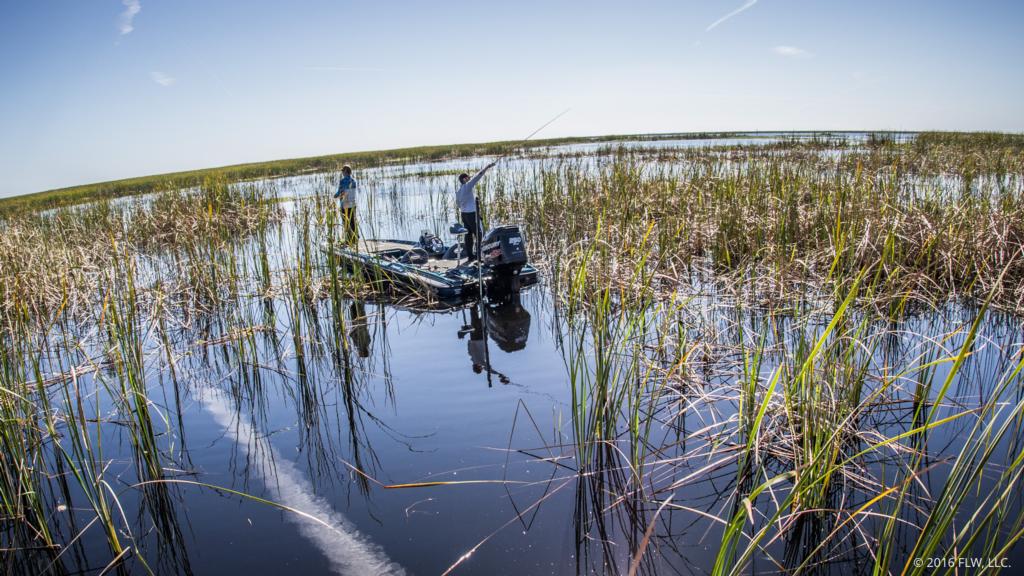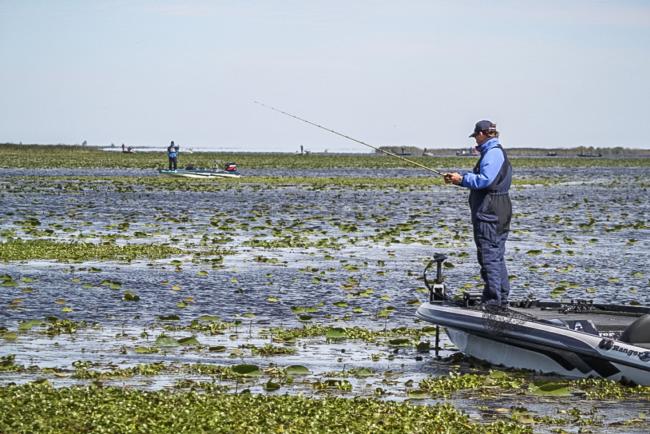Surviving Okeechobee
South Florida’s bassin’ gem can derail an AOY bid from day one, or kick start a career-making season

It’s generous, and it’s coldhearted. It’s the best of lakes, and it’s the worst of lakes. At its best, Lake Okeechobee is the greatest bass fishery in the country. At its worst, it contradicts any claims to that status.
For some of the 170 or so pros who are fishing the 2016 Walmart FLW Tour, the biggest hurdle of the year will likely come on the first day of the season, when they idle out from Roland & Mary Ann Martin’s Marina into Lake Okeechobee and are at the lake’s mercy.
Okeechobee has been a principal go-to lake for season-opening events on the Walmart FLW Tour and the former FLW Tour Opens, as well as the old Tour-level FLW Series Eastern Division. And every season, on day one, Okeechobee crushes the dreams of unfortunate anglers who simply don’t understand how to tame the unruly beast. If any such bomb droppers held Angler of the Year aspirations at season’s start, the Big O quickly disabuses them of the notion.
“That’s the one that scares everyone, or at least a ton of people, because you really don’t know how you’re going to finish,” says California pro Cody Meyer. “It can just eat your lunch. Look at Brent Ehrler. He’s an unbelievable fisherman, but for eight years he never cashed a check in Florida. Then all of a sudden he got to where he could compete to try to win. It’s just a weird place, and you can be off by a little bit and it makes all the difference in the world.”
Okeechobee’s Challenge
Don’t misjudge the lake. Okeechobee is indeed one of the greatest bass fisheries in the country. It churns out 6-pounders like most lakes churn out 3-pounders. Someone almost always catches 20 pounds – even 30 pounds – and tournament results there usually rank among the best all year. Randall Tharp won almost $200,000 and broke the century mark twice in four events on Okeechobee between 2011 and 2014.
The hang-up, however, the elusive prize that escapes most anglers, is consistency.
Meyer’s first shot at Okeechobee in 2013 resulted in a 118th-place finish. The next season, he finished fifth, but not without the lake challenging him in ways mysterious to him. For instance, he never caught fish on the same bait two days in a row until day four, when he cycled back to what worked on day one.
“I was fishing all in the same area,” he says. “You’re left thinking, ‘What just happened?’ I literally went from catching them pretty good on something to not even getting bit on it.
“You could be lost big time there,” he continues. “It’s obviously a phenomenal fishery. There are tons of fish in there – giant fish, great fish – but for some reason you could catch 25 pounds the first day and fish the same stuff and catch 7 pounds the next and not know why or how it happened.”
Even the “Greatest of All Time,” Andy Morgan, has had fits with the south Florida pond. Since 2000, he’s fished 14 FLW Tour, FLW Tour Open and FLW Series Eastern Division events on Okeechobee, with finishes (in chronological order) of 46th, 84th, 86th, third, 115th, 15th, 132nd, ninth, eighth, 90th, sixth, 72nd, 14th and 13th. Yikes, what a roller coaster.
David Dudley, FLW’s all-time leading money winner, has three top 10s on Okeechobee in those same events, but he has matched each top 10 with a finish worse than 80th. Two of those were finishes in the triple digits.
Having a bad tournament on Okeechobee doesn’t just mess up the cash flow in January or February. Because it’s the opener, Okeechobee sets the pace for an AOY run, or AOY miss.
Since 2010, no angler who went on to win AOY has averaged worse than an 18th-place finish per tournament. Quite simply, if you’re going after that crown, you can’t bomb on this, the most bomb-crater-filled lake in the country. You have to survive Okeechobee.
Gaining Momentum
Where there is potential for disaster, though, there might also be opportunity. Momentum is important in this sport. To win AOY, you have to start strong, stay strong and finish strong. You have to always be in the hunt.
A good finish at the Okeechobee opener provides the necessary momentum and confidence jolt.
“It’s always good to start off with a good tournament,” says 2015 AOY Scott Martin, an Okeechobee regular who’s earned a check in all but two openers on his home lake since 2000. “It kind of sets your year. Having a good event puts a little pep in your step.”
“In 2013 at Okeechobee, I remember coming back to the room after the tournament, and telling my roommate, ‘Dude, I’m not going to make the Cup,’ and I was down,” Meyer recalls. “I was super depressed, thinking my whole season was ruined. And it potentially could have been. Thankfully at the next event I finished eighth at Smith and moved up like 50 places in the points.
“If you start off bad, you’re playing catch-up after one event,” Meyer continues. “The next year, in 2014, I went down there and had a top five. Then I had confidence all year and just rolled with it and finished second in AOY. That event is make-or-break for sure.”
A little more factual food for thought: Since 2000, the FLW Tour (not including Opens) has kicked off on Okeechobee nine times. In those seasons, one AOY winner finished 66th at Okeechobee (Greg Hackney, 2005) and one finished 30th (Anthony Gagliardi, 2006). All the rest finished 14th or better at Okeechobee. Five made the top 10.
Success on the big lake, it seems, is a potent elixir for the rest of the season.
A Survival Kit
So how do you prosper on Okeechobee?
The lake is made for specialists. It’s such a unique fishery in a state that’s itself unique to the bass fishing world that the tackle, techniques and strategy simply don’t compare with what works in other places.
Short of wintering down and studying the lake all off-season, which is what Tharp did for several years and Randy Haynes has done more recently, an angler has to develop an understanding about what makes the Big O tick.
1. Tons of grass
At about 730 surface acres, Okeechobee is a massive lake. But big water isn’t the real issue; rather, it’s the hundreds of acres of a mix of aquatic vegetation that rims the lake’s open center. What makes an area a “better” area is often very subtle: bottom content changes, vegetation seams, how far it is from the inner and outer edges of the grass line.
“The first time I ever showed up there, I remember just being mind-boggled,” says Meyer. “You launch at Roland & Mary Ann Martin’s Marina, and you go out [through the lock] and look straight in front of you and see nothing but water and no land. Then you run up and down the lake, and it pretty much all looks the same. You really don’t know where to start.”
“There’s not another lake that looks like this in the entire country,” adds Martin. “It’s 100 percent offshore fishing in the grass. You’re not fishing down shorelines or hard cover and casting to an obvious target. You have to learn how to read the water. I can pull up to a spot and read the water, based on the grass, the clarity and several other things, and I know if it’s going to happen or not. That’s not something you can home in on fishing other lakes around the country.
“I think a lot of people approach it a little bit like luck,” Martin continues. “They think they can just get in a big area and cast around until they find them. But you have to really be thinking. You have to make decisions the whole day. There are patterns on this lake even though it doesn’t seem like it. They’re just harder to see.”
2. Muddy Water
In many parts of the South, clear water is bad water – at least for anglers used to flipping in the muck and slop. On Okeechobee, that rationale doesn’t apply.
“It took guys many, many years to finally believe that,” Martin says. “There are tournaments where we go looking for muddy water. In Florida it’s the complete opposite because if there’s muddy water you’re not going to catch them.”
3. Wind
Okeechobee is an open expanse of shallow water where wind will push mud into an area overnight. It can also raise the water level by pushing water into an area, or lower it when it recedes and the lake settles out. Meyer has seen the water level change a foot in a day because of a wind shift.
The sudden severity of change often forces anglers to completely abandon a spot – or an entire side of the lake – that has been producing.
4. Speed
With its big fish and heavy cover, Okeechobee is certainly a power fisherman’s dream lake. But “power” doesn’t necessarily require “speed.” Often, it’s the opposite.
“Many people fish too fast,” Martin says. “In Florida you have to slow down and fish effectively with patience. You can literally cast in any direction and catch a fish.”
5. Sissy Fish
A cold front trips up more anglers on Okeechobee than any other factor. When one arrives, everything changes.
“Florida fish are sissies,” Meyer jokes. “You get a cold front, and if you didn’t know better and someone asked if there was a bass that lives in there, you’d say no. It’s not that you can make them bite. They flat out just don’t bite. If you don’t have experience, it’s hard to know where to go and how to fish.”
The Experience Factor
Rookies aside, just about every pro on the Walmart FLW Tour has competed on Okeechobee. Some have been going there for two decades. They’re familiar with its quirks, yet, as the records of Morgan and Dudley show, they’re often still confounded.
Are such pros victimized by their fishing memories? Perhaps, but on a big lake like Okeechobee, sometimes it’s smart for an angler to narrow down all that water and focus in places where he’s done well before.
More likely, it’s just Okeechobee’s “personality” that causes the headaches – a personality rooted in the unique challenges of fishing in Florida for its homegrown strain of bass during the unpredictable period of time in early spring.
Yet, to win AOY, someone will have to successfully run the Walmart FLW Tour gauntlet, and the first obstacle is Okeechobee.

